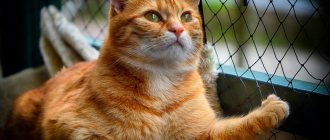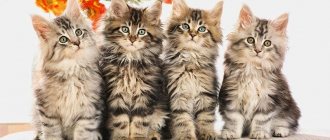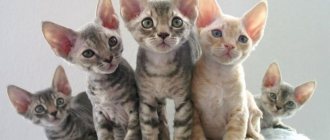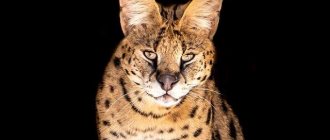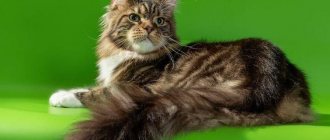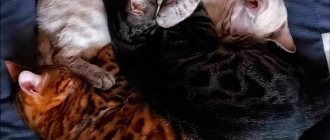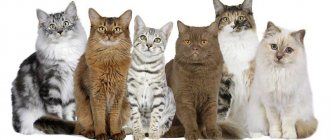The variety of colors of mustachioed pets is striking in its diversity. Animals differ from each other not only in the predominant color, but also in the degree of coloring of the hairs, as well as the presence or absence of a pattern on the coat.
All these features depend entirely on genetics, so to preserve them it is very important to follow a number of certain rules when mating. Below you can get acquainted with all the existing colors of cats and cats using photos and find out the names of the breeds to which they are assigned.
Genetics is the basis of everything
The ancestors of modern “mustachios” inhabited the hot savannas of Africa and the forests of Europe. At that time, cats used color solely for the purpose of survival and hunting. Inconspicuousness on the sand, among bushes and tree branches was achieved thanks to gray and brown tones, as well as numerous stripes and spots scattered over the entire surface of the fur coat. As a result of domestication and subsequent selection, cat colors have become more diverse and unusual.
The color of the hairs is determined by a special pigment - melanin, which is divided into 2 types:
- pheomelanin, which gives pigmentation in the red-yellow-orange spectrum by reflecting the rays of the sun;
- eumelanin, which gives black pigmentation by absorbing the rays of the sun.
Experienced cat owners will confirm that the coat of male cats has a less rich color palette. This is also explained by genetics.
Pheomelanin and eumelanin activate 2 genes: O and o, respectively. They are present only on X chromosomes, that is, the coat color is firmly linked to the sex. In the genetic code of females there are as many as 2 X chromosomes, so they have 3 basic colors available to them:
- red, or red (OO);
- black(oo);
- tortoiseshell (Oo).
Males have only one X chromosome. The latter option is not typical for them, but still sometimes occurs and is accompanied by infertility.
The genes listed are only part of a huge system. In addition to them, there are also those that are responsible for the saturation, brightness and contrast of the final color. Based on these characteristics, all existing cat colors are divided into the following types:
- solid, or solid;
- colors with white, including piebald;
- tabby, or tabby;
- tipping, or typed;
- color point, or acromelanism.
The coloring of the kittens' coat depends on the correct crossing of their parents. For this reason, breeders of purebred animals strictly monitor the pedigree and be sure to check the documents of partners for the upcoming mating.
Skookum - dwarf laperm
This dwarf, short-legged breed was developed by crossing Muncchins with Laperms.
The result was cats with short limbs and curly fur. Sukum can be either long-haired or short-haired. The shorter the fur, the straighter it is. Despite the genetic characteristics, this is a fairly healthy breed with no typical diseases found. By nature, dwarf lapermas are very cute and fluffy, which matches their appearance. Sukuma are playful, affectionate and sociable. These are very affectionate and loyal cats that are very curious and cheerful. Pets are very active, energetic and nimble, they can easily jump onto a bed or chair, and have a tendency to stick their curious nose everywhere. In addition, they are not afraid of water and enjoy swimming. In general, these are funny and cheerful cats. But, unfortunately, today they are very rare and can only be bought in European and American nurseries.
Solid colors of cats
The solid color of cats, or solid, is monochromatic. It does not contain extraneous drawings, which is completely inconsistent with the natural design. For this reason, most of the representatives from this group are the result of the hard work of breeders.
Are there completely white and black animals?
In nature, completely white and black colors do not exist. The only exceptions are unfiltered sunlight and the depths of a black hole. In the coloration of cats, such colors are achieved by multiple accumulations of spots.
The appearance of a large number of white hairs on the body is associated with the complete absence of coloring pigment in albinism or its partial suppression. In the second case, the animal becomes uniformly white due to many white spots that visually merge, or piebald.
Dominant white, a lack of color not associated with albinism, is also possible. These cats have a soft coral hue to their nose, ears, paw pads and eyelids.
The piebald color group involves the presence of colored spots on a white background and includes the following subspecies:
- Wang
. Maximum amount of white, diluted with small colored spots on the tail, head or back of the paws.
- Harlequin
. The predominance is still on the side of white, but there are more colored spots. In addition to the head, they cover the sides and back, and the entire tail is colored.
- Bicolor
. Most of the body is covered with colored spots, and the residual white creates a fancy pattern in the form of “gloves”, “medallion”, “tuxedo”, “cap”, “buttons”, “saddle” and “socks”.
- Calico, or tricolor
. The predominance of white in combination with tortoiseshell.
A completely black coat is more common than a snow-white one. It is formed by a combination of the dominant o gene and the recessive non-agouti gene, which masks the wild pattern. The features of non-agouti and body patterns will be discussed in more detail in the “tabby or tabby” section.
Rare and common colors
Common cat colors include those approved by international felinological organizations. These include:
- black;
- red;
- tortoiseshell;
- blue;
- chocolate;
- cream;
- blue-cream tortoiseshell.
If the color appeared quite recently and representatives with such a coat are difficult to breed due to their rarity, then it is not recognized. The most unusual of them include cinnamon (cinnamon), fawn (deer), apricot, and lilac.
“
INTERESTING!
Under the red and cream color, the pattern often breaks through, which makes it very difficult to achieve their uniformity.
Examples of breeds
The most notable black cat is the Bombay. A snow-white coat is typical for the Kao Mani and Turkish Angora, a chocolate coat for the Havana Brown, and a blue coat for the Chartreuse and Russian Blue.
Bobtails
Also a short-tailed group of cats. As a rule, bobtails are distinguished by their large size and dense, wet-resistant coat.
Tails can be of the following forms:
- Stump. From 2 to 5 cm. There are breaks at an obtuse angle.
- Spiral. The apparent length is 5–10 cm. There are numerous fractures, often at sharp angles.
- Retracted bobtail. Near the base the tail is normal, after 5–7 vertebrae kinks begin.
- Panicle. Length from 5 to 15 cm, breaks at right angles.
Bobtail breeds
There are several breeds of bobtails.
American
The head is wedge-shaped. The body is moderately long, the back is straight. Weight 3–8 kg. The coat can be short or semi-long.
Yankeebobs with semi-long hair should have a collar
Japanese
The head is triangular. Individuals with eyes of different colors are often found. The body is oblong, muscular, but not massive. Weight 3.5–5 kg. The coat is short.
In Japan, this cat symbolizes friendship, in Korea and China - well-being.
Kuril
The head is in the shape of an equilateral triangle. The body is strong and muscular. Weight 3–7 kg. The coat is semi-long and thick. There may be tufts on the ears, making the animal look very much like a lynx.
Thick, warm fur helped Kurilian Bobtails survive in the wild
Mekong
The head is rounded. The body is rectangular in shape, but quite slender. The only colors allowed are Siamese. Weight 2.5–5 kg.
According to legend, these animals accompanied the princesses, and while they were bathing, they strung jewelry onto the cats' broken tails.
Karelian
The head is triangular, the muzzle is narrow. The body is strong, the hind legs are noticeably longer. The coat can be short or semi-long.
Karelian Bobtail is the rarest variety
Character
Bobtails are conspicuous companions. They love to spend time in human society and are painfully sensitive to loneliness.
The most independent bobtails are the Mekong.
Most of these animals are very active and love outdoor games. They are smart and often have developed logical thinking. Most often they respond well to training. Usually travel easily.
As a rule, they get along peacefully with cats and dogs. Most of all, the “Japanese” love the company of other animals, and they prefer to be friends with representatives of their own breed.
The hunting instinct is pronounced. Many bobtails are excellent rat catchers, and some - for example, Kuril and Japanese - can fish.
Most are quite sociable, often making rich intonation sounds similar to chirping or abrupt yelps, but not to a regular meow.
The quietest and calmest of bobtails are Karelian. If such a cat needs something from its owner, he would rather touch it with his paw than meow.
Moti's character is simply unique. It’s not for nothing that kurbob is called cotops. He chose me as his owner, and it's obvious. He only sits in my arms and follows me around the house. My husband says that he even feels when I should come - he runs to the door. And when I’m not home for a couple of days, the cat... howls. Drawingly, long, like a dog. Despite the fact that both his husband and mother feed him, he keeps them at a distance. Bored, my red “Hachiko” curls up on some of my clothes. I even specially leave him some old things if I’m away for a long time, as an “anti-stress.”
Martovskaya
https://irecommend.ru/content/ne-pakhnet-i-ne-metit-ili-antikvar-v-koshachei-shkure-zabavnye-foto
Care
Short-haired bobtails are usually brushed once a week, while semi-long-haired ones are brushed once every 2-3 days. During the molting period, this is done daily. If necessary, you can bathe the animal approximately once every 2 months.
Video: Kurilian Bobtail - all the details about the breed
Tabby, or tabby
Tabby is the most ancient coloring, inherited by domestic cats and cats from their wild ancestors. It is distinguished from solids by the presence of a pattern that facilitates mimicry - camouflage to the environment.
Varieties
Tabbies are characterized by zonal hair coloration, which is a uniform alternation of dark and light areas, like on a police baton. Depending on the order of arrangement and appearance of the lines inside the color, 4 subspecies are distinguished:
- Spotted
. The body of the animal is covered with round spots of different sizes. On the tail and in the lower part of the limbs the shape changes to oval and can merge into stripes.
- Marble
, or
classic
. It is a combination of wide spiral stripes diverging on the sides and reminiscent of marble stains. In addition to this feature, the fur coat has spots in the belly area, rings along the tail and paws, as well as 3 stripes in the area of the shoulder blades, similar to the open wings of a butterfly. - brindle
, or
mackerel
. Characterized by thin vertical stripes scattered throughout the body. The rings are found strictly on the tail and limbs, and a continuous dark stripe runs along the spinal column. - Ticked
. This color is found in Abyssinian cats, so it is sometimes carried separately. Its detailed description will be given below.
Another gene is responsible for the appearance of the pattern on the coat - agouti, as well as its possible form, or allele - non-agouti. The first makes the tabby distinguishable, while the second suppresses and disguises it. Thus, in the presence of non-agouti, the tabby turns into a solid.
“ INTERESTING!
Protection from the effects of non-agouti is only provided by the O gene, which is responsible for the red and cream tint. For this reason, all fluffy saffron milk caps have an open pattern, which can only be removed through painstaking breeding work.
Residual tabby in kittens confirms that all whiskered pets are tabbies, but not all are agoutis. Because of this, with solid colors, the pattern disappears immediately after the juvenile molt.
Examples of breeds
The most famous “mustache” with a marbled coat is the short-haired British kitten from the Whiskas advertisement. The presence of spots is typical for savannahs, Ocicats and Bengals. Stripes are the least common. They can be found in the Toyger, a close relative of the Bengal.
History of the Munchkin breed
Mentions of short-legged cats appeared in different countries. So, for example, in 1944 in Great Britain, in 1954 in the USSR (the archives mentioned the “Stalingrad Kangaroo Cat” - due to the ability to assume the position of a marmot), in 1970 in New England, and in the 1980s in USA. In 1983, Sandra Hochenedel from Louisiana adopted a pregnant stray cat, naming her Blackberry, which began the history of the Munchkin breed. The cat gave birth to kittens, among which were babies with short legs. Geneticist Dr. Solveig Pfluger, to whom Sandra turned for help, confirmed that the kittens were healthy and that the short legs were the result of a spontaneous genetic mutation. She and a kitten from her litter were used to crossbreed with domestic cats.
In 1991, breeders interested in developing a new breed tried to get the Munchkin breed recognized by TICA, but recognition was not received because little was known about the breed. A repeat attempt in 1994 was successful. But when this happened, TICA member Catherine Crawford resigned because she considered the recognition of the breed an insult, because short legs can cause numerous back problems, although there is no evidence of this. From the beginning of breeding work to the recognition of the breed, breeders were subjected to comprehensive attacks by animal rights activists and representatives of felinological organizations. Breeders were accused of conducting inhumane experiments that lead to the appearance of ugly monsters. Oddly enough, the controversy surrounding the breed contributed to its growing popularity. Munchkin cats are loved for their unusual appearance and easy and friendly disposition.
The breed appeared in Russia in 2001, where the popularity of munchkins is slowly but growing. But in Japan, these cats are literally worshiped; the breed is one of the most popular.
Ticked cat colors
The main feature of ticked color in cats is the vagueness of the pattern. It's like he's covered with a light veil. Residual stripes are observed only on the muzzle. Its relationship with other varieties of tabby can be determined by the mesmerizing shimmer of the coat, achieved through zonal hair coloring.
Initially, ticking was found only in “Abyssinians,” but over time, breeders achieved its manifestation in other breeds: Ragamuffin, Chausie, “British,” LaPerma, Cornish Rex, “Oriental,” Manx and others.
The requirements for these animals are much lower than for Abyssinian cats. Their standard allows for open “necklaces” on the neck, the letter “M” on the forehead (scarab sign) and stripes around the paws and tail.
Caring for a short-legged pet
Representatives of short-legged breeds need regular brushing and require daily bathing. Ear cleaning and eye rinsing procedures are required.
Cats do not like water, but hairless breeds should be taught to use water. Sweat and dust accumulate on the animal's body and must be removed. These cats can get sunburned or freeze in cold temperatures
It is important to monitor your pet's exposure to air.
Singapura cat
Short-legged cats do not need walking, but they will happily walk on fresh grass. Cats are not good at climbing and jumping, so it is recommended to ensure that your family pet does not fall and get injured.
Kittens should be fed 6 times a day, and adults up to 4 times a day. The diet should include protein. It is not recommended to feed raw fish. Kittens are fed special food.
Tipping
On average, when ticking, the hair is divided into 3 alternating zones. Tipping is a fairly close concept, but has two differences:
- Number of zones. Usually there are only two of them: light at the bottom and dark at the top.
- Mechanism of coloring. The lower part of the hair is lightened to white by complete or partial loss of pigment due to the dominant silver gene. In the first case, it becomes white, and in the second, yellow or apricot.
Depending on the degree of black coloration, several varieties are distinguished in this group. As with tabbies, the final color of a cat when tipped is determined by the presence of the agouti gene.
Haze and shaded
Haze and shaded colors are similar, but still separate varieties. In both places there is a dominant silver gene, but its manifestation depends on the agouti gene:
- Smoky
. Owners of this color carry the non-agouti allele in their chromosomes, which excludes the pattern. Because of this, the smoky coat of cats is often confused with a plain coat. The silveriness appears strictly when moving, when the hairs move apart and expose almost 50% of the white base.
- Shaded
. With this variety, only ⅓ of the hair is dyed. Due to the presence of the agouti gene, a pattern is formed on the fur coat, creating the effect of a translucent veil.
Depending on the color of the tips of the hairs, the haze can be blue, purple, black, chocolate and red. The presence of residual stripes in smoky colors is not allowed.
“ REFERENCE!
In addition to the standard haze, there is also a reverse haze, when it is not the base of the hairs that is painted white, but their ends.
Silver and gold
In this section, it is important to clarify that, unlike solids and tabbies, tipping is only a method of coloring. It is not a separate group of colors in cats. The color variations created by tipping are called silver. In addition to haze and shaded, 2 more colors are classified as silver:
- Silver tabby
. A unique option for zonal coloring with lightening of light areas to whiteness. The dark shade in this case retains its original color. Thanks to this, a pattern characteristic of a tabby appears on the body.
- Veiled, or chinchilla
. It is characterized by coloring only ⅛ of the hair. As with the ticked paint, the chinchilla will be disassembled separately just below.
Both varieties, like the shaded one, appear under the condition of the simultaneous presence of the silver and agouti genes. The first suppresses the production of both types of melanin, but has a greater effect on pheomelanin.
If there is an excess amount of red pigment (red and cream coat), its blocking fails. It gives a unique cameo color, when instead of dark tips, light ones are formed. As in the case of a chinchilla, the dyed part accounts for ⅛ of the total length of the hair.
“ NOTE!
The blue coat is often confused with the silver coat, but it still belongs to the solids. This confirms the absence of a white base in the hairs.
Unlike silver, gold consists strictly of red-yellow-orange colors. With this coloring, the color is preserved in both zones, but the upper one is painted more brightly and intensely. If the top layer accounts for ⅓ of the hair, then the color is called shaded gold, and if only ⅛, then veiled. In both cases, the golden cat is always green-eyed.
The golden color of the fur coat is the most expensive and rare. It is difficult to breed as the exact reason for its inheritance has not yet been identified. Mating of two golden individuals does not always give the desired result, since any inconsistency of genes leads to the suppression of pheomelanin.
Examples of breeds
The smoky color, like many others, is allowed by the American Curl standard. A brighter owner of the haze is the Australian mist, or Australian smoky. A silver coat is the calling card of the oriental beauty of Singapore, and bright gold is the most expensive color option for the chubby-cheeked “British”.
Chinchilla
With this color in cats, only the very tip of the hair is colored, and most of it remains white. The name “chinchilla” was given for a reason. The coat of animals with this color really resembles the fur of rodents or an arctic fox fur coat. An additional bonus is the extraordinary softness and fluffiness.
In addition to silver chinchillas, golden ones are also found. They are distinguished by a soft apricot undercoat. Regardless of the final color, all chinchillas have black eye and nose rims, black paw pads and bright green eyes.
Scottish Fold
Another cat with round ears is called the Scottish Fold. This is a very cheerful and friendly animal that does not require special care. The characteristics of the breed are:
- Medium-sized body with thick, pleasant-to-touch, plush-like fur.
- The head has a rounded muzzle and round whisker pads.
- The wide-set ears have an unusual shape - their upper part is bent so that it hides the pinna.
- Round big eyes. We allow them to have different colors, but they must match the color of their coat.
- The nose is wide.
- The tail is medium in size, tapering towards the end.
The round shape of the ears is the result of a genetic mutation in the simplest domestic cat. Animals with good care can live up to 15 years, but owners should remember two weak points of the breed. These are diseases of the joints (the tail is especially dangerous) and the heart. Cats are also prone to overeating.
Color point or acromelanism
The English phrase color point is translated as “color spot”. With this color, kittens are born blue-eyed and almost snow-white. With age, most of their body remains either white or changes to cream, and its extremities (muzzle, tail, ears, paws) darken and acquire more saturated colors:
- tortoiseshells;
- solids;
- tabby
Color point is a form of albinism. It is part of the group of acromelanistic colors that depend on body temperature. So-called points, or dark spots, appear where it is colder. The snow-white appearance of kittens is the result of their high temperature, which is 38.5-39.5°C. In adults, this figure is much lower – 37.5-38.9°C.
Varieties by shade
Depending on the main color of the cat and its point, several subspecies are distinguished in this group. These include:
- blue point - blue;
- chocolate point – brown;
- tortoiseshell (tri-color);
- lilac point – gray-pink;
- seal point – dark brown-gray, close to black;
- red point – red (red);
- cream point – cream (beige);
- tabby point - spotted or striped.
The acromelanism gene can also produce full albinos. Such cats not only have little, but basically no melanin. Because of this, not only their fur coat loses color, but also the iris. Albino cats have either pinkish-red or blue eyes. In the first case, the color comes from blood vessels, and in the second, from reflected rays of light.
Examples of breeds
An alternative name for color point is Siamese. It’s easy to guess that its main owners are the graceful and big-eared Siamese. Acromelanism also appears in their close relatives – Thai and Himalayan cats.
Content Rules
How to keep a cat with large ears depends solely on the breed to which it belongs. If you become the proud owner of a Turkish Angora, you will have to regularly comb out its luxurious fur with a slicker brush, and after that still clean horizontal and vertical surfaces from the consequences of its presence. If you have a Savannah or a beautiful Abyssinian galloping around your house, know that everything that is possible will be pulled out and studied from every corner of the house, so make sure that there are no beads or sharp objects in its access area.
Carefully consider the diet for your pet, consult a veterinarian. Get all the necessary vaccinations according to the schedule, and then be sure to take your cat for a preventive examination at least once every 6 months. If your cat walks outside, be sure to take timely anti-tick and anti-parasitic measures. If it is possible to purchase and put a tick collar on your animal, do so.
At home, a cat should have its own place to play, sleep and eat. Clean drinking water should always be available. Take care of a hygienic area where the cat can calmly go about his big and small business without disturbing family members.
For safety reasons, install screens on your windows, especially in the summer. Get rid of the habit of throwing windows wide open, because cats do not always measure the height from which they fall, and often suffer from this. Do not leave your pet alone for a long time; they get very bored when they are alone. And, bored, they may become offended and arrange a “surprise” for their owner when he returns.
To find out what breeds of cats with big ears there are, see the following video.
American Curl
- Lifespan: 9-13 years
- Temperament: Athletic, outgoing, friendly, family-oriented, sociable
- Color: white, black, blue, silver, red, lilac, chocolate, gold, cream, tortoiseshell
- Height: up to 30 cm
- Weight: 3.6-5.4 kg
- Comparable breed: Korat, Nibelung
The American Curl is the result of a spontaneous natural mutation. The breed originated in 1981 in Southern California. They are medium-sized cats with an athletic build, long tails and folded-back ears with long tufts of fur, which gives them their name.
American Curls not only look athletic, but also have significant athletic qualities. They will love climbing cat trees and perches, and they won't shy away from the highest places in the house. They are passionate about climbing and love to play even in old age . The American Curl is unlikely to want to curl up on your lap, but it will enjoy being close to you. These cats are sociable and people-oriented.
Aphrodite
- Lifespan: 12-15 years
- Temperament: sociable, calm, attention-seeking, loving, affectionate
- Color: all colors except lilac, mink, chocolate, fawn and point
- Weight: 5-11 kg
Aphrodite, also known as the Cyprus cat, is a giant, short-haired, energetic and playful cat breed. Experts believe that this cat breed originated in the mountainous regions of Cyprus and, due to its large size, could easily hunt large predatory animals.
The cats are large, have long hind limbs and luxurious, thick fur , which help them climb and adapt to mountain conditions. Due to their enormous size, Cyprus cats take up to three years to reach full size.
Although Cypriot cats have been around for almost 10,000 years, it was only in 2012 that the Aphrodite giant cat breed was officially recognized by the World Cat Federation. There are still wild populations of this breed in Cyprus. They are often described as cat-like dogs when it comes to relationships with their owners.
Best friend for a child
For a home with small children, it is worth choosing a cat with the most docile and gentle disposition, but with a strong constitution and the ability to support active games. Pets will help your baby learn responsibility and care.
For families with children, Scottish and British, Persians and exotics, Angoras with medium-length fur, Burmese and Orientals are best suited.
For allergy sufferers, the best pet would be the Canadian Sphynx.
For younger schoolchildren and teenagers, an ideal companion and friend would be a representative of the Maine Coon breed.
Read more in the article about the best cat breeds for children.
Features of care and susceptibility to disease
Gene mutations in brachycephalic cats cause breathing problems. Both kittens and adult cats often snore in their sleep and smack their lips while eating. They suffer from upper respiratory tract infections more often than other breeds and experience discomfort associated with increased lacrimation due to their close-set eyes. When you have a cold, the conjunctiva becomes inflamed and purulent discharge is observed.
Flat-faced felines are susceptible to allergic reactions to pollen and dust.
The diet of brachycephalics should be balanced and varied. Breeders note that they are extremely demanding on the quality of food and prefer dry or wet premium and super premium food, natural food - poultry, white fish, fresh vegetables and herbs. Animals often have digestive problems, so they should not be fed food from the table, given whole cow's milk, sweets, or smoked meats.
Caring for cats with flat fashion is not burdensome, but requires compliance with a number of rules:
- animals must be protected from frost, drafts and temperature changes;
- feed with premium food;
- clean your eyes daily with alcohol-free wet wipes or cotton pads soaked in clean water or tea leaves;
- Inspect and clean the ears once a week; cleaning ears for folds is especially important;
- Visit your veterinarian regularly to watch for breathing problems that develop in older animals.
These rules will help keep your pets healthy and minimize problems associated with brachycevalia.
Peterbald
- Lifespan: 12-15 years
- Temperament: smart, affectionate, active, acrobatic, friendly, curious
- Coloring: many colors and patterns
- Height: 20.3-30.5 cm
- Weight: 3.2-6.3 kg
- Comparable breed: Sphynx, Oriental cat
The Peterbald is a Russian breed, first bred in St. Petersburg in 1994, which is how it got its name. The cat was obtained as a result of experimental breeding by Olga Sergeevna Mironova, who mixed the genes of the Don Sphynx and the Oriental Shorthair cat.
The most striking physical characteristic of the Peterbald is that it is hairless, although varying degrees of baldness occur. You might think that a hairless cat requires less time and effort to groom, but this is not true. Yes, she won't need brushing, but she will need weekly bathing. Peterbalds also need to eat more due to their faster metabolism .
The Peterbald is the closest thing to a dog as a four-legged companion. He will play, sit with you and even enjoy a good walk.
Black breeds of cats and male cats: photos, description of character
Black cats are quite common. Almost all breeds can have this color: both short-haired and long-haired. It is believed that black cats have special telepathic abilities and sense their owners well. There are few breeds that are exclusively black in color.
The Bombay cat is a breed that has been created by breeders for more than 20 years. The animal has smooth short hair and is very similar in appearance to a panther. Throughout life, a cat's eye color changes: at birth it is blue, then becomes gray, and then acquires an amber tint.
Features of this breed:
- have a bright temperament
- have a very individual character
- have high intelligence
- they meow a lot, but their voice is quiet, so they are perceived without tension
- don't like loneliness
- happy to sit in your arms
- balanced
- they try to take a leading position among other pets
Mandalay
Bombay cat is a new rare breed that is not fully recognized. These are descendants of Burmese with a specific thick, uniform dark chocolate or black color. The wool literally shimmers and feels silky and pleasant to the touch.
Main features:
- calm and friendly
- love all family members without singling out anyone
- patient
- love affection and attention
Mandalay
Khao-mani
- Height: 25.4-30.5 cm
- Body weight: 3.6-4.5 kg
- Lifespan: 10-12 years
- Temperament: sociable, affectionate and courageous
First mentioned in classical Thai literature as early as 1350, khao mani, meaning “white gem,” immediately gained popularity. These light-eyed cats were prized by Thai aristocrats, considered sacred and protected by the ruling class for centuries.
The Khao Mani is one of the most expensive cat breeds in the world with a price tag of around $7,000-$11,000 . These rare cats are said to bring good luck to their owners.
These cats are sociable, curious and completely devoted to their family. Energetic and quite intelligent, Kao Mani love interactive games and quickly get along with children and other playful pets.
Toyger
- Lifespan: 10-15 years
- Temperament: affectionate, sociable, easy to train, intelligent
- Colour: red or brown with dark vertical stripes
- Height: 23-33 cm
- Weight: 3.2-6.8 kg
- Comparable breed: Bengal cat
The Toyger is a designer breed, which means that breeders deliberately designed its body markings. They set out to create a tiger-like domestic cat , and they certainly succeeded. But despite its resemblance to a tiger, this domestic cat is known for its affectionate disposition and loyalty to all family members of all ages, two-legged and four-legged.
These short-haired tabby cats were first bred in 1980. The International Cat Association recognized the Toyger in 2007, although other registries do not officially recognize the breed.
